This section requires Javascript.
You are seeing this because something didn't load right. We suggest you, (a) try
refreshing the page, (b) enabling javascript if it is disabled on your browser and,
finally, (c)
loading the
non-javascript version of this page
. We're sorry about the hassle.
2 solutions
nice approach !
Let the position coordinates of A , D , C be ( 0 , 0 ) , ( 2 b , 0 ) , ( b , 0 ) respectively. Then those of B are ( 2 b , 2 4 a 2 − b 2 ) , where a = ∣ B C ∣ = ∣ A B ∣ . Solving equations for A B and D E we get the position coordinates of E as ( 8 a 2 b 3 , 8 a 2 b 2 4 a 2 − b 2 ) . Let D E and B F meet at G . Then the position coordinates of G are ( 1 6 a 2 b 3 + 4 a 2 b , 1 6 a 2 b 2 4 a 2 − b 2 ) .
So, the slope of B G is m 1 = b 4 a 2 − b 2 8 a 2 − b 2 .
Slope of C E is m 2 = 8 a 2 − b 2 − b 4 a 2 − b 2 .
So, m 1 m 2 = − 1 ⟹ ∠ B F C = 9 0 ° .

can have this